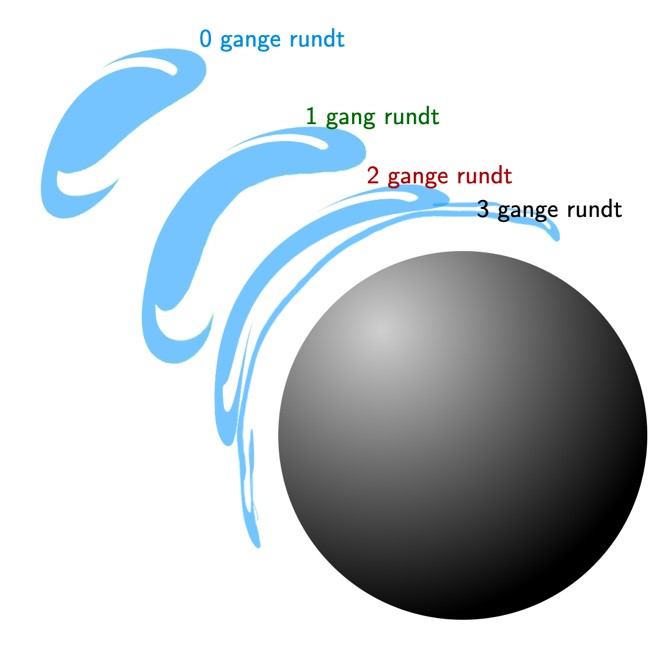
In the vicinity of black holes, space is so warped that even light rays may curve around them several times. This phenomenon may enable us to see multiple versions of the same thing. While this has been known for decades, only now do we have an exact, mathematical expression, thanks to Albert Sneppen, student at the Niels Bohr Institute. The result, which even is more useful in realistic black holes, has just been published in the journal Scientific Reports.
You have probably heard of black holes — the marvelous lumps of gravity from which not even light can escape. You may also have heard that space itself and even time behave oddly near black holes; space is warped.
In the vicinity of a black hole, space curves so much that light rays are deflected, and very nearby light can be deflected so much that it travels several times around the black hole. Hence, when we observe a distant background galaxy (or some other celestial body), we may be lucky to see the same image of the galaxy multiple times, albeit more and more distorted.
Galaxies in multiple versions
The mechanism is shown on the figure below: A distant galaxy shines in all directions — some of its light comes close to the black hole and is lightly deflected; some light comes even closer and circumvolves the hole a single time before escaping down to us, and so on. Looking near the black hole, we see more and more versions of the same galaxy, the closer to the edge of the hole we are looking.

How much closer to the black hole do you have to look from one image to see the next image? The result has been known for over 40 years, and is some 500 times (for the math aficionados, it is more accurately the “exponential function of two pi”, written e2π).
Calculating this is so complicated that, until recently, we had not yet developed a mathematical and physical intuition as to why it happens to be this exact factor. But using some clever, mathematical tricks, master’s student Albert Sneppen from the Cosmic Dawn Center — a basic research center under both the Niels Bohr Institute and DTU Space — has now succeeded in proving why.
“There is something fantastically beautiful in now understanding why the images repeat themselves in such an elegant way. On top of that, it provides new opportunities to test our understanding of gravity and black holes,” Albert Sneppen clarifies.
Proving something mathematically is not only satisfying in itself; indeed, it brings us closer to an understanding of this marvelous phenomenon. The factor “500” follows directly from how black holes and gravity work, so the repetitions of the images now become a way to examine and test gravity.
Spinning black holes
As a completely new feature, Sneppen’s method can also be generalized to apply not only to “trivial” black holes, but also to black holes that rotate. Which, in fact, they all do.

“It turns out that when the it rotates really fast, you no longer have to get closer to the black hole by a factor 500, but significantly less. In fact, each image is now only 50, or 5, or even down to just 2 times closer to the edge of the black hole”, explains Albert Sneppen.
Having to look 500 times closer to the black hole for each new image, means that the images are quickly “squeezed” into one annular image, as seen in the figure on the right. In practice, the many images will be difficult to observe. But when black holes rotate, there is more room for the “extra” images, so we can hope to confirm the theory observationally in a not-too-distant future. In this way, we can learn about not just black holes, but also the galaxies behind them:
The travel time of the light increases, the more times it has to go around the black hole, so the images become increasingly “delayed”. If, for example, a star explodes as a supernova in a background galaxy, one would be able to see this explosion again and again.

